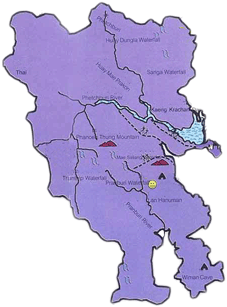Bird
Watching

Birdwatching Location
at Kaeng Krachan National Park

|
|
|
|
|
|
Kaeng
Krachan is located on the eastern slope of the Tenasserim Mountain
Range at the border of Burma (Myanmar). It occupies the western half of
Phetchaburi Province (Amphur Kaeng Krachan and Amphur  Nong
Ya Plong) and a portion of northern Prachuab Khiri Khan Province (Amphur
Hua Hin).
Nong
Ya Plong) and a portion of northern Prachuab Khiri Khan Province (Amphur
Hua Hin).
The National Park was designated on June 12, 1981; its original borders
encompassed 1.5 million rai. On April 20, 1983, Thalerng Thamrongnawasawad,
Peramnent Secretary of the Ministry of Agriculture and Cooperatives, presided
over the offical opening ceremony. On December 27, 1984, the park area
was extended, as proposed by the Hua Hin Environmental Conservation Group,
to cover the boundary between Phetchaburi and Prachuab Khirikhan Provinces,
bringing the total area to over 1.8 million rai.
The
area, about 45 squares kilometers, consists of both ground and water in reservoir. The vastly forest upper
the Kang Kra Jan Dam is on complicated mountain ranges which the highest
peak is 1,200 meters above sea level and approximately high 500 meter
above sea level. Most of the mountains are Granite Mountain, few are Limestone
Mountains, and many are full of fluoride. And also most of the area is
covered by rain forest so that is the source of Phet Buri River and Pran
Buri River.
consists of both ground and water in reservoir. The vastly forest upper
the Kang Kra Jan Dam is on complicated mountain ranges which the highest
peak is 1,200 meters above sea level and approximately high 500 meter
above sea level. Most of the mountains are Granite Mountain, few are Limestone
Mountains, and many are full of fluoride. And also most of the area is
covered by rain forest so that is the source of Phet Buri River and Pran
Buri River.
The
park is compossed of two major watersheds. About half of the
area drains to the Phetchaburi River, which flows to Kaeng Krachan dam
at the eastern edge of the park and then down through farmland to the
provincial capital of Phetchaburi. The southern haft of the park drains
to the Pranburi River, which flows south to the Pranburi dam and then
on to the town of Pranburi in Prachuab Khiri Khan Province. Because of
abundant rainfall and undisturbed forest cover in these watersheds, the
streams, waterfall and rivers of Keang Krachan flow year round.  The
park is composed of two major watersheds and a large evergreen forest.
About half of the area drains to Phetchaburi River, which flows to Kaeng
Krachan dam and the southern half of the park drains to the Pranburi River.
Humidity remains high throughout the year, with heavy rain during the
rainy season and cool weather for much of the year. The steep forested
areas of the park are even more humid than the young forest and cleared
lands in the lower elevations.
The
park is composed of two major watersheds and a large evergreen forest.
About half of the area drains to Phetchaburi River, which flows to Kaeng
Krachan dam and the southern half of the park drains to the Pranburi River.
Humidity remains high throughout the year, with heavy rain during the
rainy season and cool weather for much of the year. The steep forested
areas of the park are even more humid than the young forest and cleared
lands in the lower elevations.
